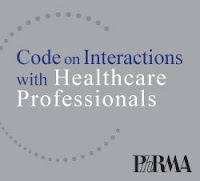 Our hats are off to the Pharmaceutical Research & Manufacturers of America task force on professional practices. It is no simple matter to get three dozen companies to agree on anything—much less something as politically and commercially sensitive as the rules governing marketing to physicians.
Our hats are off to the Pharmaceutical Research & Manufacturers of America task force on professional practices. It is no simple matter to get three dozen companies to agree on anything—much less something as politically and commercially sensitive as the rules governing marketing to physicians.And to do so in a way that addresses real-world, day-to-day operations is so much tougher. PhRMA’s updated Code on Interactions With Healthcare Professionals wrestles with the nitty gritty details of how physician marketing works, and doesn’t shy away from tough, specific directives on everything from pens to meals.
So no one can say PhRMA is hiding behind bland statements of principle rather than addressing the real world.
But perhaps you can say the opposite: that in getting into the weeds of how marketing works, PhRMA has lost site of some bigger principles. Debates over pizza and pens may help in that cause, but they don’t come close to justifying marketing as a vital, necessary activity for society.
In that spirit, may we suggest three modest proposals of our own?
Step One: Define the Mission
It is time (past time, perhaps) for PhRMA and its members to redefine the role of marketing and reclaim the high ground.
Every marketing organization should have a mission statement that it can embrace and brag about. The goal cannot be simply to increase sales. The goal should be to ensure the widest appropriate use of life-improving or life-extending medicines. Marketing done right means a medicine reaches more of the right people; it maximizes the benefit society receives from medical science.
PhRMA’s updated code on interactions with physicians suggests this mission in the preamble: “Appropriate marketing of medicines ensures that patients have access to the products they need and that the products are used correctly for maximum patient benefit.”
Hopefully, every marketing organization believes that already. The hard part is convincing the rest of the world to see it that way.
To do that, you can’t just say that’s what marketing is—you have to mean it. For example, do companies compensate marketing personnel based on “maximum patient benefit”? Its hard to say yes if sales reps get bonuses for boosting prescription market share in their territory: that is compensation based on maximizing revenue.
Of course, coming up with bonuses tied to maximizing appropriate use requires some real creativity, and probably a complete rethinking of the marketing effort.
But that’s only step one.
Tomorrow: Step Two--Combine the Codes
No comments:
Post a Comment